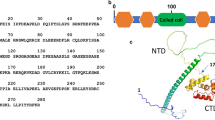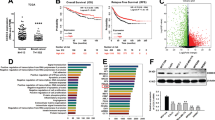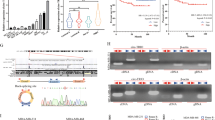Abstract
Aberrant accumulation of β-catenin is closely related to carcinogenesis. Mutations in the p53 gene are reported to induce the aberrant accumulation of β-catenin in the absence of dysfunction in the glycogen synthase kinase 3β (GSK3β)-mediated degradation pathway, but the mechanism remains incompletely understood. Here, we show that human coiled-coil domain containing 85B (CCDC85B) is induced by p53 and regulates β-catenin activity via interaction with the T-cell factor 4 in the nucleus. Moreover, CCDC85B enhances the degradation of β-catenin and suppresses tumor cell growth. In conclusion, we revealed that CCDC85B-induced degradation of β-catenin is independent of GSK3β and other p53-inducible products, Siah-1L, suggesting that CCDC85B constitutes the one of the frameworks of p53-induced multiple regulatory pathways for β-catenin activity.
This is a preview of subscription content, access via your institution
Access options
Subscribe to this journal
Receive 50 print issues and online access
$259.00 per year
only $5.18 per issue
Buy this article
- Purchase on Springer Link
- Instant access to full article PDF
Prices may be subject to local taxes which are calculated during checkout





Similar content being viewed by others
Accession codes
Abbreviations
- CCDC85B:
-
coiled-coil domain containing 85B
- DOX:
-
doxorubicin
- GSK3β:
-
glycogen synthase kinase 3β
- LEF:
-
lymphocyte enhancer binding factor
- LiCl:
-
lithium chloride
- siRNA:
-
short interfering RNA
- TCF:
-
T-cell factor
References
Brazas R, Ganem D . (1996). A cellular homolog of hepatitis delta antigen: implications for viral replication and evolution. Science 274: 90–94.
Cagatay T, Ozturk M . (2002). P53 mutation as a source of aberrant beta-catenin accumulation in cancer cells. Oncogene 21: 7971–7980.
Chung DC . (2000). The genetic basis of colorectal cancer: insights into critical pathways of tumorigenesis. Gastroenterology 119: 854–865.
Harris SL, Levine AJ . (2005). The p53 pathway: positive and negative feedback loops. Oncogene 24: 2899–2908.
Hart MJ, de los Santos R, Albert IN, Rubinfeld B, Polakis P . (1998). Downregulation of beta-catenin by human Axin and its association with the APC tumor suppressor, beta-catenin and GSK3 beta. Curr Biol 8: 573–581.
He TC, Sparks AB, Rago C, Hermeking H, Zawel L, da Costa LT et al. (1998). Identification of c-MYC as a target of the APC pathway. Science 281: 1509–1512.
Henderson BR . (2000). Nuclear-cytoplasmic shuttling of APC regulates beta-catenin subcellular localization and turnover. Nat Cell Biol 2: 653–660.
Hurlstone A, Clevers H . (2002). T-cell factors: turn-ons and turn-offs. EMBO J 21: 2303–2311.
Iwai A, Marusawa H, Matsuzawa S, Fukushima T, Hijikata M, Reed JC et al. (2004). Siah-1L, a novel transcript variant belonging to the human Siah family of proteins, regulates beta-catenin activity in a p53-dependent manner. Oncogene 23: 7593–7600.
Klein PS, Melton DA . (1996). A molecular mechanism for the effect of lithium on development. Proc Natl Acad Sci USA 93: 8455–8459.
Lee TK, Lau TC, Ng IO . (2002). Doxorubicin-induced apoptosis and chemosensitivity in hepatoma cell lines. Cancer Chemother Pharmacol 49: 78–86.
Lee E, Salic A, Kirschner MW . (2001). Physiological regulation of [beta]-catenin stability by Tcf3 and CK1epsilon. J Cell Biol 154: 983–993.
Matsuzawa SI, Reed JC . (2001). Siah-1, SIP, and Ebi collaborate in a novel pathway for beta-catenin degradation linked to p53 responses. Mol Cell 7: 915–926.
Park WS, Oh RR, Park JY, Kim PJ, Shin MS, Lee JH et al. (2001). Nuclear localization of beta-catenin is an important prognostic factor in hepatoblastoma. J Pathol 193: 483–490.
Prange W, Breuhahn K, Fischer F, Zilkens C, Pietsch T, Petmecky K et al. (2003). Beta-catenin accumulation in the progression of human hepatocarcinogenesis correlates with loss of E-cadherin and accumulation of p53, but not with expression of conventional WNT-1 target genes. J Pathol 201: 250–259.
Roose J, Clevers H . (1999). TCF transcription factors: molecular switches in carcinogenesis. Biochim Biophys Acta 1424: M23–37.
Sadot E, Geiger B, Oren M, Ben-Ze'ev A . (2001). Down-regulation of beta-catenin by activated p53. Mol Cell Biol 21: 6768–6781.
Stambolic V, MacPherson D, Sas D, Lin Y, Snow B, Jang Y et al. (2001). Regulation of PTEN transcription by p53. Mol Cell 8: 317–325.
Tetsu O, McCormick F . (1999). Beta-catenin regulates expression of cyclin D1 in colon carcinoma cells. Nature 398: 422–426.
Tolwinski NS, Wieschaus E . (2001). Armadillo nuclear import is regulated by cytoplasmic anchor Axin and nuclear anchor dTCF/Pan. Development 128: 2107–2117.
Watashi K, Hijikata M, Tagawa A, Doi T, Marusawa H, Shimotohno K . (2003). Modulation of retinoid signaling by a cytoplasmic viral protein via sequestration of Sp110b, a potent transcriptional corepressor of retinoic acid receptor, from the nucleus. Mol Cell Biol 23: 7498–7509.
Willert K, Nusse R . (1998). Beta-catenin: a key mediator of Wnt signaling. Curr Opin Genet Dev 8: 95–102.
Acknowledgements
This work was supported by grants-in-aid for cancer research and for the second-term comprehensive 10-year strategy for cancer control from the Ministry of Health, Labour and Welfare as well as by Grant-in-Aid for Scientific Research on Priority Areas ‘Integrative Research Toward the Conquest of Cancer’ from the Ministry of Education, Culture, Sports, Science and Technology of Japan.
Author information
Authors and Affiliations
Corresponding author
Additional information
Supplementary Information accompanies the paper on the Oncogene website (http://www.nature.com/onc).
Rights and permissions
About this article
Cite this article
Iwai, A., Hijikata, M., Hishiki, T. et al. Coiled-coil domain containing 85B suppresses the β-catenin activity in a p53-dependent manner. Oncogene 27, 1520–1526 (2008). https://doi.org/10.1038/sj.onc.1210801
Received:
Revised:
Accepted:
Published:
Issue Date:
DOI: https://doi.org/10.1038/sj.onc.1210801
Keywords
This article is cited by
-
Prioritization and functional validation of target genes from single-cell transcriptomics studies
Communications Biology (2023)
-
Coiled-Coil Domain-Containing (CCDC) Proteins: Functional Roles in General and Male Reproductive Physiology
Reproductive Sciences (2021)
-
Network-based analysis of oligodendrogliomas predicts novel cancer gene candidates within the region of the 1p/19q co-deletion
Acta Neuropathologica Communications (2018)
-
Gene expression associated with PTSD in World Trade Center responders: An RNA sequencing study
Translational Psychiatry (2017)
-
The HSA21 gene EURL/C21ORF91 controls neurogenesis within the cerebral cortex and is implicated in the pathogenesis of Down Syndrome
Scientific Reports (2016)



